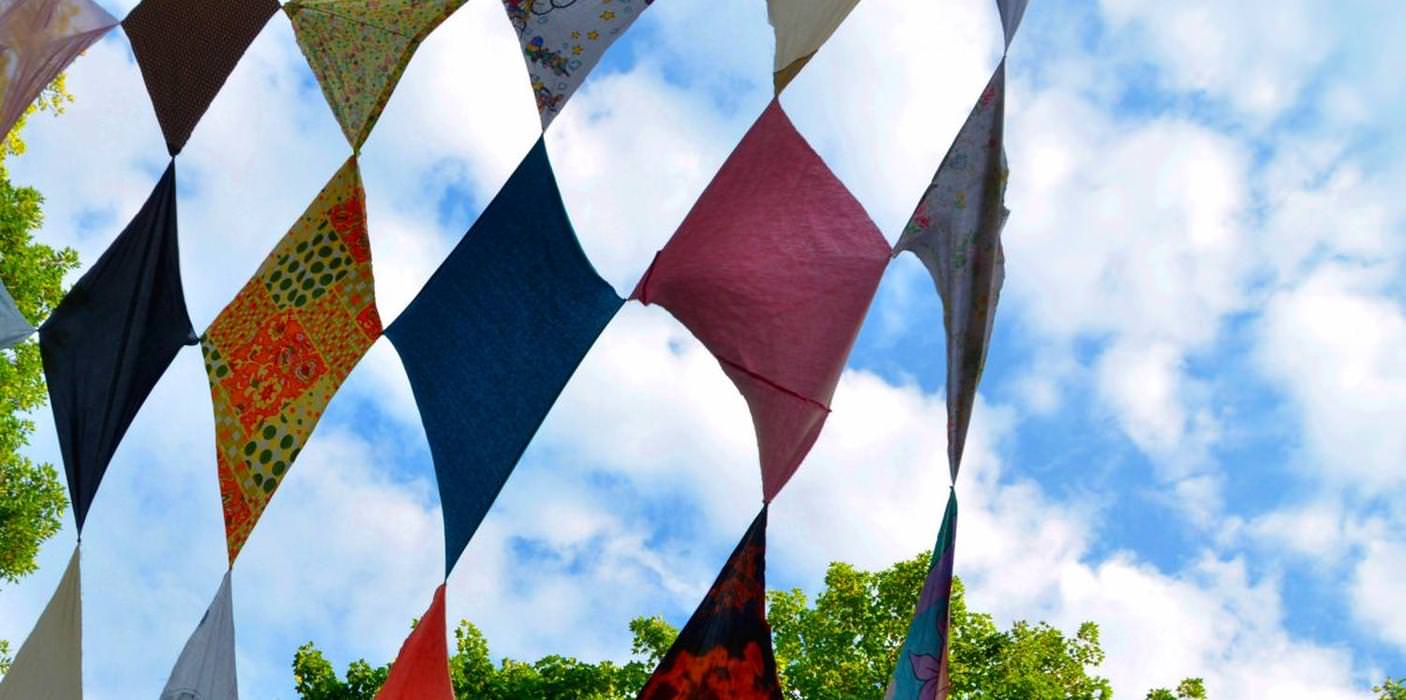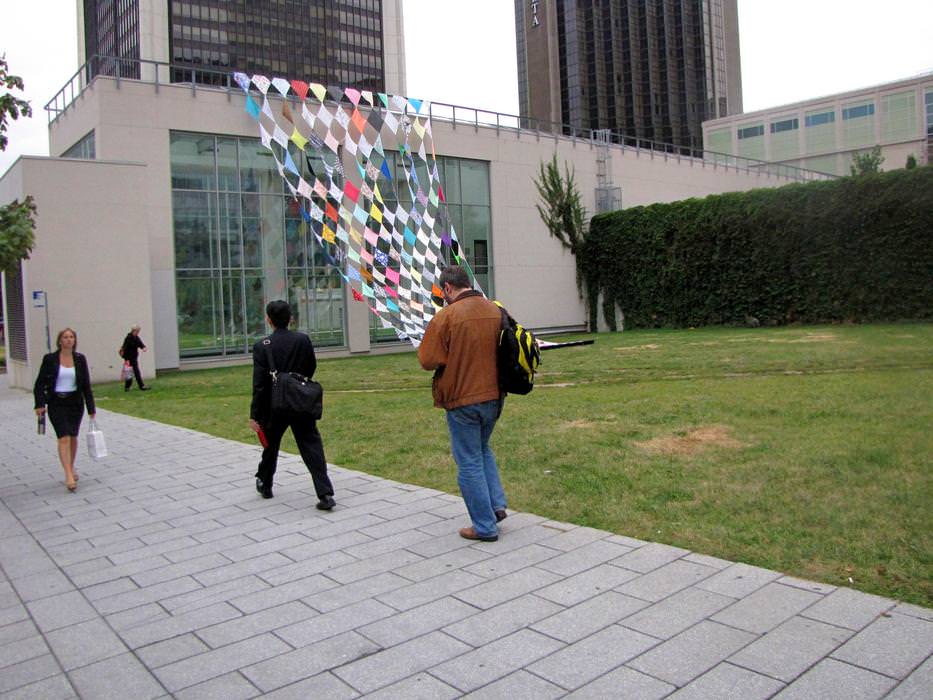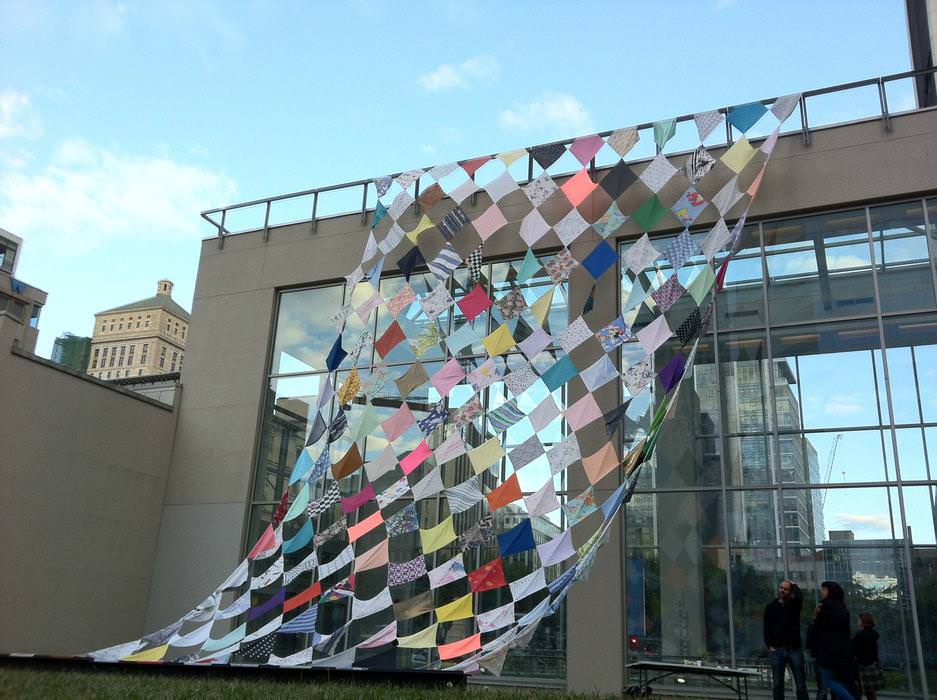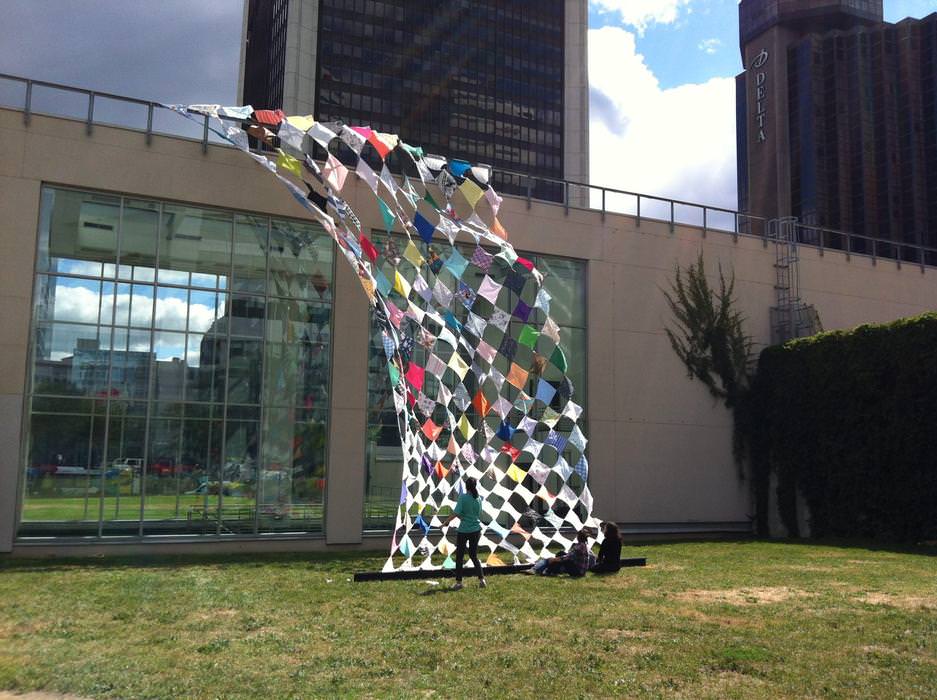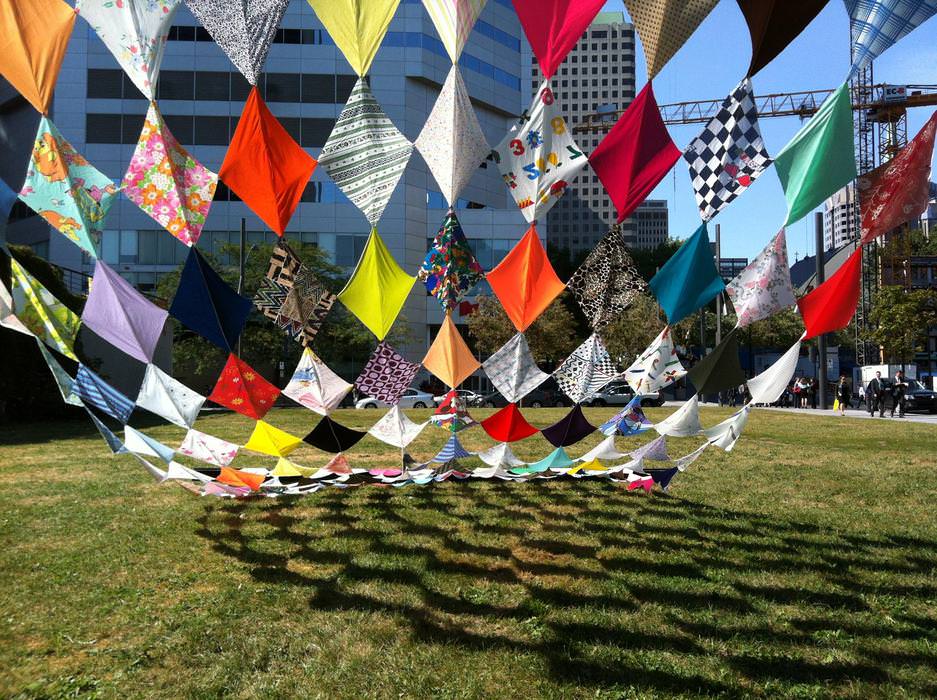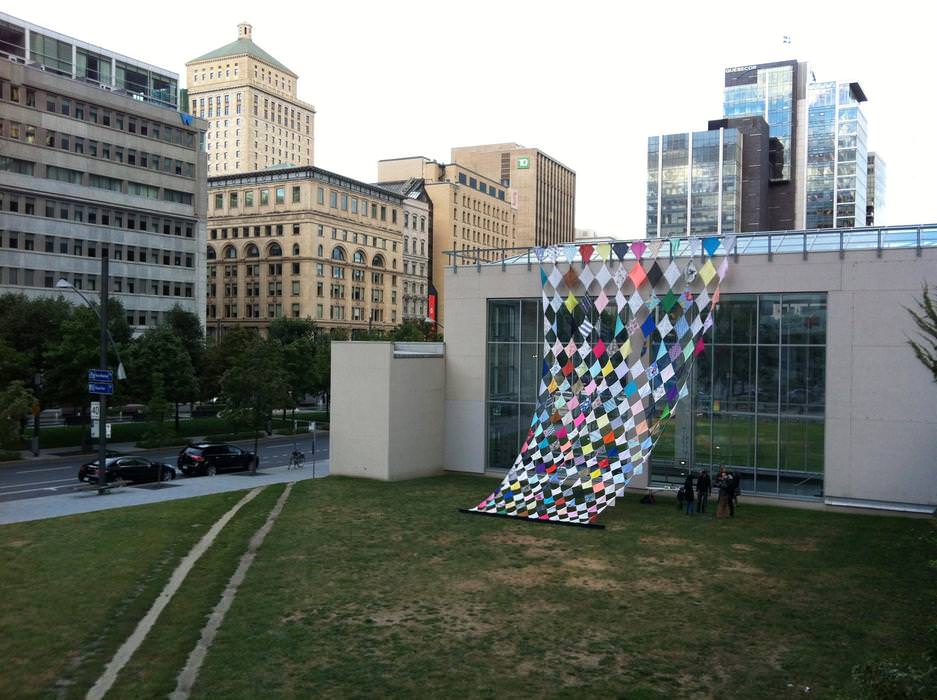Programmation
STÉPHANIE CHABOT
CIEL PERCÉ
Cette majestueuse bannière aérienne, composée d’innombrables pièces de tissus assemblées, viendra égayer pour quelques jours un espace public du Quartier international de Montréal.
Voir plus
DARE-DARE présente du 10 au 17 septembre prochain l’installation éphémère Ciel percé de l’artiste Stéphanie Chabot. Cette majestueuse bannière aérienne, composée d’innombrables pièces de tissus assemblées, viendra égayer pour quelques jours un espace public du Quartier international de Montréal.
Installé à proximité du Square Victoria, Ciel percé est un plan incliné textile culminant à près de 40 pieds de hauteur. La bande trapézoïdale s’étale sur une course de près de soixante pieds de long, tendue entre la corniche d’un immeuble du Quartier international et une esplanade gazonnée adjacente, créant sous l’oblique colorée de cette couverture souple, une étroite aire invitante.
Le contraste entre la facture artisanale de cet ouvrage –son allure à la fois festive et bigarrée– et l’austérité de l’atrium vitré du siège de l’OACI sur lequel il s’accroche surprendra à coup sûr. En effet, l’esthétique bricolée de Ciel percé s’apparente d’avantage à un abri de fortune façonné pour s’amuser ou au quadrillé arlequin d’un campement forain qu’à une œuvre publique d’un grand centre urbain.
La démesure de cet assemblage crée de bric et de broc et l’aspect ludique et spectaculaire de Ciel percé nous rappellent le besoin de rêver et de rendre le monde fantastique. La répétition d’une même unité –le drap de lit– rappelle pour sa part l’échelle du corps et l’espace domestique. Humanisant du coup, par ces touches chargées d’une portée personnelle et intime, ce lieu au caractère officiel et sévère. Par la diversité de ses composantes la toile amalgame le bon et le mauvais goût, forçant à se côtoyer des motifs léopard criards, des Mickey Mouse souriants et des imprimés fleuris réconfortants. Il en ressort une sorte de portrait de société évoquant la diversité sans pour autant masquer les contrastes parfois dissonants qui la compose. L’apparente fragilité et la délicatesse des pièces cousues s’avèrent par ailleurs d’une grande flexibilité et d’une impressionnante résistance. L’artiste met en valeur, par les jeux de percées et de transparence de la toile, le contexte dans lequel elle s’infiltre. La courtepointe se marie à son environnement et fait vibrer de ses motifs colorés les matières industrielles qui composent la ville, tout comme le bleu changeant du ciel.
Présence de l'artiste sur le site 10 septembre 2012
// 18@19h //
Au coin de l'avenue Viger ouest et de la rue du Square Victoria
Suivie d'une soirée festive au Pub Victoria
698 Notre-Dame Ouest, Montréal, H3C 1J2
L’artiste tient à remercier: Pierre Terzian, Mélissa Robertson, Nadine Duclos, Geneviève Massé et toute l'équipe de DARE-DARE.
Stéphanie Chabot vit et travaille à Montréal. Depuis l’obtention d’un baccalauréat de l’Université Concordia en peinture et dessin, sa pratique s’est élargie pour inclure l’installation multimédia, la sculpture et la vidéo. L’artiste est aussi titulaire d’une maîtrise de l’Université York de Toronto. Sa pratique est basée sur une imagerie où s’entremêlent les clichés de la culture populaire à une mythologie personnelle. Son travail a été exposé dans plusieurs centres d’artistes et galeries au Canada, ainsi qu’en Angleterre, en Australie et en Espagne. Stéphanie Chabot a été très impliquée au centre d'artistes La Centrale et ce à divers titres. Elle est depuis peu la coordonnatrice générale du Centre des arts actuels Skol.
Retour sur Ciel Percé de Stéphanie Chabot
Par Jacqueline Hoang Nguyen
You don't need to pray to God any more when there are storms in the sky, but you do have to be insured.
– Bertolt Brecht
Conceived as a temporary public artwork in Downtown Montreal, Stéphanie Chabot's installation Ciel percé is composed of used fabrics in diamond-like shapes. Attached to each other by their corners, the fabrics create a checkered-like pattern, resembling an unfinished patchwork. The various patterns on the years-worn and washed-out printed fabrics show disparate cartoon characters or domestic flower contours, materials that once inhabited our childhood and now compose the hidden corners of our home today.
Located in the vicinity of the Victoria Square, Ciel percé functions like waving mnemonic fragments from the past or like a used floating working class quilt. The area where the artwork was installed is called the International Quarter, known for its 'prestige address' as the global face of the city. The carefully chosen site is a public park situated directly between the Montreal World Trade Centre and the Montreal Exchange, where financial derivatives are traded. In the 1980s Canada put in motion its neoliberal turn – a shift most easily recognized when Paul Gobeil, a Liberal member of the National Assembly famously said in 1986: « Il faut runner l'État comme une business » (translation: "The state has to be run like a business"). These developments followed a long period, between 1982 and 1995, of exhaustion from the social model established in the traces of the Quiet Revolution. [1] This very same site became the ground for Occupy Montreal where over one thousand Montrealers participated in the occupation movement. Hoping to attract the government’s attention to serve the interests of the other 99%, tents were raised in the square from mid-October before being evicted on November 25, 2012.
Chabot's installation Ciel percé came a year after this pacific occupation that abode the economical centre of Montreal. The work hung, on one end, from the edge of the International Civil Aviation Organization (ICAO) – a specialized agency of the United Nations to promote the safe and orderly development of international civil aviation throughout the world – and, on the other end, affixed to the ground forming a structure that recalls a one-sided survival shelter. Contrasting with the surrounding environment of skyscrapers, this malleable installation comprised of bedsheet scraps stitched together floated in the air. While a year earlier tents offered temporary refuge to the protestors, Chabot's tent-like installation offers to mediate between human subjectivities connected through bedclothes, the most intimate sector of the private sphere. Whether the viewer stands inside or outside the soft structure, she is positioned between a "soft" and a "hard" place – between that which signifies women's labour and the domestic, and that which signifies men's work and the public, i.e. Victoria Square or the centre stage for the flux of capital. The textiles articulate the nuances and inflections of social meaning in its physical proximity to the larger institution of the International Quarter. Thus, Ciel percé reminds us of today's contested relationship between citizenship and labour. The artwork revives the citizen, rather than the consumer, in us by its dissonant flashy patterns, bright but washed out colors, and seemingly unreasonable scale.
Marking the same site that was seized by Occupy Montreal, Chabot explores complex layers of social meaning and addresses the political as it relates to labour, culture, identity, protest and display. The work is both a literal and a symbolic gesture – an insertion into what might seem to be an otherwise impervious and unbreakable system. While Montreal’s looming downtown horizon of erect skyscrapers portends an all-encompassing capitalism where consumption and capital would be our saviour, Ciel percé signals that the sky is now perforated, that our vision for a new skyline needs to be re-defined with a place for the people and its social fabric.
[1] Richard Fidler, "What is Neo-Liberalism?," Occupy Toronto
September 27, 2012, http://www.occupyto.org/2012/09/what-is-neo-liberalism/ (accessed on January 4, 2013).
Born and raised in Montreal (CA), French-Canadian of Vietnamese origin, Jacqueline Hoang Nguyen is a research-based artist currently based in Brooklyn (NY) and Stockholm (SE). Nguyen recently completed the Whitney Museum of American Art’s Independent Study Program (Studio 2010-2011). She obtained her MFA and a post-graduate diploma in Critical Studies at the Malmö Art Academy in Malmö, Sweden (2003-2005), and had previously completed her BFA degree with distinction at Concordia University in Montreal, Canada (1999-2003).
